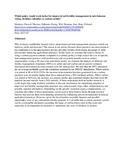| dc.contributor.author | Marenya, Paswel | |
| dc.contributor.author | Nkonya, Ephraim | |
| dc.contributor.author | Xiong, Wei | |
| dc.contributor.author | Deustua, Jose | |
| dc.contributor.author | Kato, Edward | |
| dc.date.accessioned | 2013-06-26T07:10:22Z | |
| dc.date.available | 2013-06-26T07:10:22Z | |
| dc.date.issued | 2012-07 | |
| dc.identifier.citation | Marenya, P. et al(2012). Which policy would work better for improved soil fertility management in sub-Saharan Africa, fertilizer subsidies or carbon credits? Agricultural systems; 110: 162-172 | en |
| dc.identifier.uri | http://www.sciencedirect.com/science/article/pii/S0308521X12000698 | |
| dc.identifier.uri | http://erepository.uonbi.ac.ke:8080/xmlui/handle/123456789/40166 | |
| dc.description | Journal article | en |
| dc.description.abstract | Why do many smallholder farmers fail to adopt improved land management practices which can improve yields and incomes? The reason is not always because these practices are uneconomical but sometimes it is because resource poverty prevents farmers from taking advantage of yield and income enhancing agricultural practices. In this study we examine the relative merits of using a carbon payment scheme compared to a subsidy policy to help reduce the cost of specific land management practices with productivity and ecosystem benefits such as carbon sequestration. Using a 30-year crop simulation model, we examine the impacts of different soil fertility management treatments (SFTs) on yields and soil carbon and proceed to compute discounted incremental revenue streams over the same period. We find that the SFTs simulated are on average profitable given the conditions assumed in our DSSAT simulations. When carbon was priced at $8 or $12/t CO2e, the increase in incremental incomes generated from a carbon payment were invariably higher than those imputed from a 50% fertilizer subsidy. When carbon was priced at $4/Co2e, the increase was almost similar and sometimes higher than that from the imputed income transfer from a 50% subsidy. If these indications hold in further research, it could imply that using fertilizer subsidies as the sole mechanism for stimulating adoption of improved soil fertility management practices may unnecessarily forgo other complementary and possibly superior alternatives. Depending on the specific economic equity considerations, we conclude that either of these instruments can be used to help farmers break through resource barriers that prevent them from adopting productivity-enhancing and environmentally beneficial agricultural practices. However, given the fiscal burden on public finances and possible opportunity costs of any substantial subsidy program, it is possible that a carbon payment system can be a reasonable alternative assuming the range of carbon prices used in this study and especially if accompanied by measures to ameliorate the costs of fertilizer to farmers. | en |
| dc.language.iso | en | en |
| dc.subject | Soil fertility | en |
| dc.subject | Fertilizer subsidy | en |
| dc.subject | Carbon payments | en |
| dc.subject | Net present value | en |
| dc.subject | Sub-Saharan Africa | en |
| dc.title | Which policy would work better for improved soil fertility management in sub-Saharan Africa, fertilizer subsidies or carbon credits? | en |
| dc.type | Article | en |
| local.publisher | Department of Agricultural Economics, University of Nairobi, Kenya | en |

